
This is the Old Rock Building, built by hand by the Jesuits seminarians and brothers out of rock they cut themselves from the bluffs overlooking the nearby Missouri River. It replaced an earlier log structure. In its earlier days, this seminary of 999 acres was self-supporting, like the monasteries of old. This was one of the first seminaries west of the Mississippi River.
The school that was to become the seminary was founded in 1823 by eight Belgian Jesuits, at the encouragement of Bishop Louis DuBourg of the Diocese of Louisiana and the Two Floridas, and U.S. President James Monroe. The missionaries built a log school for Indian children, and 17 years later opened the seminary.
This was the home base of Father Pierre De Smet, who traveled 200,000 miles on foot, mule, and boat, and made 19 ocean crossings in his missionary journeys.
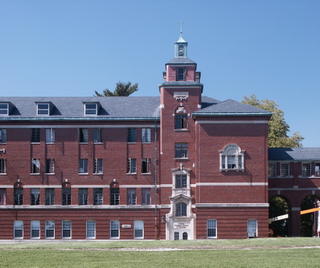
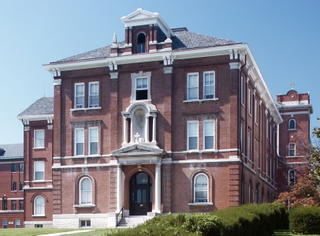
Thousands of Jesuits lived and studied in these buildings.
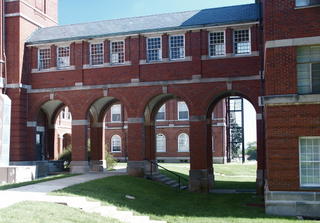
This covered walkway is an example of the excellent detail found in classic Catholic buildings.

The imposing chapel.
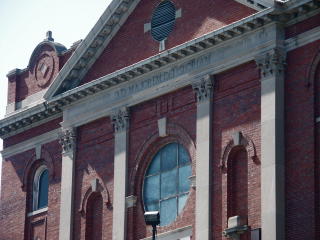
Detail of the pediment of the chapel, showing the popular motto of the Society of Jesus " AD MAJOREM DEI GLORIAM" ("for the greater glory of God").

This little hill, the Memorial Mound, is an Indian burial mound and was also the Jesuit cemetery for the entire Missouri Province. Some remains and the tombstones were removed in 2002, the remains going to Calvary Cemetery in Saint Louis. Father Pierre De Smet was buried here; but only a few fragments of his skeleton were recovered. Most of the Jesuits were reinterred in a mass grave. The mound has not been fully excavated.
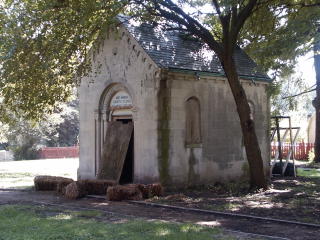
An old mausoleum on the grounds. Above the doorway is the Angelic Salutation.
The chaos in the culture following the Second Vatican Council led to the quick demise of the seminary. The combination of sexual libertinism, changing catechesis and liturgy, psychological experimentation, and great wealth, killed vocations.
The Collection of the Western Jesuit Missions, at Saint Louis University, opened in 2003: http://www.sjweb.info/world/museum_west_missions/index.cfm
An archive web site describing the Museum of the Western Jesuit Missions, that used to be housed in the Old Rock Building: http://www.usgennet.org/usa/mo/county/stlouis/jesuit/mwjm.htm
More photos of the Collection: http://www.geocities.com/davidjsuwalsky/
[UPDATE: see the newer article on the Collection of the Western Jesuit Missions.]
Map of location


St. Mary of the Barrons, whose spiritual successor is Kenrick- Glennon Seminary is actually the first seminary founded west of the Missisippi. (The diocesan Seminary separated from the Vincentian seminary in 1842, 2 years after the start of St. Stanislaus.) It was founded in 1818 by DuBourg with the help of Bishop Rosati, and Felix de Andreis (whose cause for canonization has been stalled for more than 100 years) It is also the first graduate school, St. Louis University was founded a couple of months later, as a diocesan college, the Jesuits only coming in 1824.
ReplyDeletehttp://www.newadvent.org/cathen/01470c.htm
http://www.kenrick.edu/History/history.html
What a great place to start a real traditional Catholic college (both in terms of episcopal openness and in terms of missionary spirit and history). Do you think the Pentecostals would sell? Anybody got a few million bucks? Where's our traddie Tom Monahagn when we need him?
ReplyDeleteI love your idea, Curmudgeon!
Delete40 years ago on March 28, (1968), A bus broke down on its way to St. Stanislaus Seminary. I was 12 years old. The bus broke down and they parked it on the parking lot of Buchholz Mortuary on Jennings Station Road in Jennings,Missouri. My back yard was on the backside of the parking lot. There were 2 'Brothers' that stayed with the bus and there names were Greg Stevens S.J. and Steve Yavorsky S.J. My girlfriends and these young Brothers chatted for a few hours. I am sitting here today looking through my childhood autograph book and came across the autographs of these two men. I can still remember it so like it was not too long ago. Steve Yavorsky S.J. wrote out the Hail Mary in Greek for me. I thought that was the neatest thing as a 12 year old. I am thinking of framing it. I do wonder what happened to these brothers. I typed in the Seminary name only to find out it is no longer there. I moved to Cape Girardeau from St. Louis in 1979. I would love to hear how these two are doing or if they even continued with their journey. Thanks, Pam B. in Southeast Missouri.
ReplyDeleteHello Pam B.
DeleteI am Steve Yavorsky, S.J. I first stumbled onto your post a few years ago, but didn't know how to reply. I was thrown off by the word "anonymous" at the top of the message. I guess I just didn't see the link below. But now I've found it. Don't know whether you'll get this but, yes, I too remember that conversation. . This is written on August 13, 2013.
Do u have any knowledge of father Jim carney? He went there I think thx
DeleteDoes anyone know any information or have any photos
ReplyDeleteof Fr. Angelo Ziccardi SJ? He was a jesuit priest from Italy who served sometime in early 20th century, he was at Saint Stanislaus Seminary.
Thank you for your help.
I was a seminarian at St. Stanislaus from 1951-1955. Fr. Ziccardi was there in retirement. One day we had a funeral of a Jesuit priest who, like others, was being buried in the cemetary there. Most funerals of old priests were sedate, quiet and somber. This priest had been the pastor at an African-American church, and many, many of his flock were there This funeral was anything but somber and quiet.This parishioners were lamenting like nothing I had ever seen or heard. We were stunned, amazed, and inspired. Later, we heard, Fr. Ziccardi told his fellow priests, in his strong Italian accent, something like "Now this was a real funeral. This is the way all funerals should be!"
DeleteTom Cooke (cooketd@earthlink.net
I am so very interested in your post above. One of my great uncles was buried here in 1953. He was the pastor of the old St Elizabeth's Church, 2721 Pine Street, St Louis - the pioneer church for African-Americans - from about 1919 to 1935. Your comment makes me curious if this could have been Fr John DeVilbiss S.J. The only way we know that he is buried here is from his death certificate indicating it.
DeleteIn the late 60s, I used to work at the infirmary at St. Stanislaus Seminary. By then the seminary was close but there were 15 or 20 elderly priests and brothers who lived in the old living quarters there. Brother Michael Finn was a registered nurse who oversaw the care of the residents there. I was a college student and worked on weekends when Brother Finn was off duty. It was a wonderful job and the grounds were beautiful back then. I remember that all of the buildings were connected by underground tunnels.
ReplyDeleteThe final story of this Seminary and its proud history is a sad one. In I believe 2002 the Jesuit provincial provoked a lawsuit. he demanded that all the items collected by Fr. Heithaus SJ be returned to be displayed at a museum planned at St.Louis University. The museum board rejected this and a lawsuit ensued. The jesuits prevailed in court,the items removed and the building was closed. To add a final dose of salt to an ugly wound it was demanded that the historic cemetery to the seminary be condemned and the bodies of all these pioneers of the Missouri province be taken to Calvary cemetery. This was done and thus closed a wonderful chapter in the life of the Catholic faith in Florissant
ReplyDeleteAbout the little mausoleum. This housed the remains of Mrs. Barney Blake who was a generous benefactor to the Missouri province. In the early 1970s she was disinterred and her body removed to Calvary Cemetery. She is in the new section of the cemetery near to her beloved Jesuits. Sadly the former mausoleum became a neglected embarrassment. The windows were broken out. the door ripped off, the cross on top torn down, the inside defaced and it in general became a 'party house' and a public toilet. This is just one more sad chapter in the dreary demise of this once proud institution.
ReplyDeleteThe campus is no longer Gateway College of Evangelism. While it is still owned by Pentecostals, it is now one institution which holds both an accredited graduate school (Urshan Graduate School of Theology) and an Christian College which is currently seeking accreditation (Urshan College). This previous year, the mausoleum was restored to a prayer chapel by a concerned professor at the institution, Dr. Joey R. Peyton. He removed the garbage that had been carelessly thrown into it, repainted it, installed new windows, and put in wooden floors and benches. It is already being used again as a place of prayer for not only students and faculty of the college, but also members of the local community.
ReplyDeleteI visited the Mausoleum/Chapel today - it was inspiring and in very good condition. Thanks for those who recovered it for the community and history
DeletePaulo Costa
I am glad to see that this has been done. It was terribly neglected and I am happy to hear that it has been restored and brought back to life. Congradulations to all who had a hand in and especially to Dr. Peyton. Someday I would like to visit. Again, congradulations !
DeleteI grew up in the neighborhood behind this monastery and my mom and I would walk the property at night. Nothing strange ever happened.......ever. we even walked through the cemetery and while doing so a man came out and walked us through some of the building. Its a very beautiful place
ReplyDelete